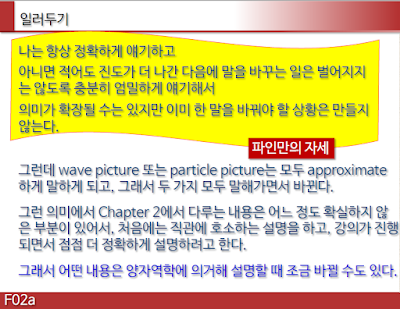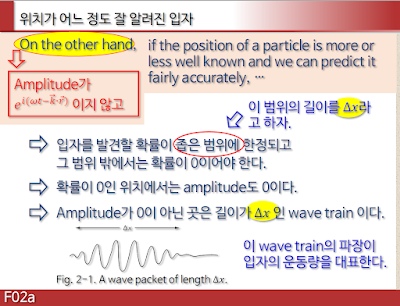[참조] 차교수의 물리 산책: 파인만 양자역학 2장/1강[강의][원문]
[처음][이전][다음]
[주의] ------------------------------------------------------------------------------------
파인만 양자역학을 내맘대로 번역하고 약간의 해설을 달아 봤습니다. 한글 해석과 덧붙인 [주]는 저의 개인적인 생각 이므로 그대로 받아 들이진 말아 주세요. 하지만 칭찬, 동의, 반론, 지적등 어떤 식으로든 의견은 환영 합니다.
-------------------------------------------------------------------------------------------
[처음][이전][다음]
[주의] ------------------------------------------------------------------------------------
파인만 양자역학을 내맘대로 번역하고 약간의 해설을 달아 봤습니다. 한글 해석과 덧붙인 [주]는 저의 개인적인 생각 이므로 그대로 받아 들이진 말아 주세요. 하지만 칭찬, 동의, 반론, 지적등 어떤 식으로든 의견은 환영 합니다.
-------------------------------------------------------------------------------------------
Chapter 2. The relation of wave and particle viewpoints)
2장. 파동과 입자 관점의 차이
2장. 파동과 입자 관점의 차이
2–1. Probability wave amplitudes
2-1. 확율 파동 진폭
In this chapter we shall discuss the relationship of the wave and particle viewpoints. We already know, from the last chapter, that neither the wave viewpoint nor the particle viewpoint is correct.
이번 장에서는 [양자적 행동이 지배하는 미시세계의 대상을] 파동으로 다루는 시각(viewpoints)과 입자로 다루는 시각의 상관성[차이점]에 대해 살펴보려고 한다. 지난 장에서 이미 입자의 관점 만으로 뿐만 아니라 파동의 관점 만으로는 다룰 수 없다는 것을 알게 됐다.
We would always like to present things accurately, or at least precisely enough that they will not have to be changed when we learn more—it may be extended, but it will not be changed!
우리는 늘 배운 것들은 명확하게 기록해 두길 좋아한다. 적어도 나중에 더 많이 알게된 후에도 지금 표현한 내용을 수정하지 않아도 될 정도로 최소한의 정확성을 갖길 바란다. 그것(지식)들은 확장될 것이고 변하지 않을 것이다.
But when we try to talk about the wave picture or the particle picture, both are approximate, and both will change. Therefore what we learn in this chapter will not be accurate in a certain sense; we will deal with some half-intuitive arguments which will be made more precise later. But certain things will be changed a little bit when we interpret them correctly in quantum mechanics. We are doing this so that you can have some qualitative feeling for some quantum phenomena before we get into the mathematical details of quantum mechanics.
하지만 우리가 파동의 관점 또는 입자의 관점으로 다루려고 할 때, 둘 모두 간략화[근사화]해서 다뤄지고 모두 바뀔 것이다. 따라서 우리가 이 장에서 배울 것은 어떤 면에서는 명확하다고 볼 수 없다. 반쯤은 직관적(half-intuitive)인 논제를 통해 다룰 것이기 때문이다. 이 직관적인 부분은 후에 더 정확하게 다루겠다. 하지만 어떤 점은 양자역학으로 해석하면서 정확성 제고를 위해 다소 변경 될 것이다. 직관적인 이해를 위해 양자역학을 수학적으로 접근하기 전에 양자적 현상을 정성적(qualitative)으로 느껴보기로 한다.
[주] 고전 물리학은 입자와 파동을 분리하고 있다. 이런 고전 물리학의 관점으로 양자역학이 지배하는 대상들을 설명하기 어렵다. 그렇더라도 이전의 물리학을 버릴 수 없다. 일단 고전적인 관점으로 양자역학의 대상들을 살펴볼텐데 이 과정에서 정확하지 않은 부분이 있을 수도 있다. 추후 두 관점을 통합하면서 불명확성을 수정해 나가기로 한다.
Furthermore, all our experiences are with waves and with particles, and so it is rather handy to use the wave and particle ideas to get some understanding of what happens in given circumstances before we know the complete mathematics of the quantum-mechanical amplitudes.
아울러 양자역학에서 말하는 진폭(amplitude)에 대한 수학을 확실히 배우기 전에 어떤 상황에서 무슨일이 일어나는지 이해를 돕고자 파동과 입자에 관해 우리가 경험으로 알고 있는 생각들을 이용하는편이 직관적 이해에 유리하다(handy).
[주] 양자역학의 진폭(amplitude)은 입자의 확률분포를 구하는 기초자료 였다는 점을 기억해 두어야 한다.
We shall try to indicate the weakest places as we go along, but most of it is very nearly correct—it is just a matter of interpretation.
계속 (논의를) 진행해 가면서 가장 약점인 부분[정성적인 느낌으로 이해 했으나 변경이 필요했던 것들]을 드러내도록 하려고 한다. 그것들은 비록 취약했던 부분이었지 틀렸다고는 볼 수 없다. 단지 [어느 관점으로 볼 지] 해석의 문제였을 뿐이다.
First of all, we know that the new way of representing the world in quantum mechanics—the new framework—is to give an amplitude for every event that can occur, and if the event involves the reception of one particle, then we can give the amplitude to find that one particle at different places and at different times. The probability of finding the particle is then proportional to the absolute square of the amplitude. In general, the amplitude to find a particle in different places at different times varies with position and time.
먼저, 우리는 양자역학적으로 세계를 표현하는 새로운 방법, 새로운 구도(framework)에 대해 알게됐다. 그것은 일어날 수 있는 모든 사건(event) 마다 '진폭['확율진폭'을 뜻한다]'을 부여하는 방법이다. 그리고 만일 한 사건에 한 입자를 받아들인 다면 그 입자가 저마다 어느시간 어느장소에 떨어질지 알아내기 위해 진폭[=확률진폭]을 줄 수 있다. 입자를 발견할 확율은 이 진폭의 절대값을 제곱하여 구한다. 일반적으로 저마다의 장소와 시간에서 입자를 발견할 진폭은 위치와 시간에 좌우된다.
[주] '확률진폭'은 시간과 위치(공간)의 함수다.
--[경우 1] 확율진폭을 파동함수로 정의한 경우의 불확정성 ------------------
In some special case it can be that the amplitude varies sinusoidally in space and time like e^(i(ωt−k⋅r)), where r is the vector position from some origin. (Do not forget that these amplitudes are complex numbers, not real numbers.)
확률진폭(the amplitude)이 시간과 공간을 변수로 둔 정현파(sinusoidal; 사인과 코사인 포함한 통칭)로 정의된 한 특별한 예를 들어보자. [1장에서 봤다시피] 지수함수 e^(i(ωt−k⋅r)) 로 나타낼 수 있다. 이때 r 은 원점에서의 위치로 공간 벡터다. (이 진폭은 허수(complex-number) 체계로 실수(real-number)가 아님에 유의하자.)
Such an amplitude varies according to a definite frequency ω and wave number k. Then it turns out that this corresponds to a classical limiting situation where we would have believed that we have a particle whose energy E was known and is related to the frequency by
그렇게 표현된 '진폭'은 고유의 주파수(definite frequency) ω 와 파수(wave number) k 에 따라 변한다. 이 [양자역학의] '확률진폭'은 제한적인 상황[고전역학에서 파동을 표현할 때 주파수와 파수 만을 변수로 사용한다는 조건]과 일치하는 것으로 밝혀졌다(turn out). 에너지 E 를 가진 입자는 다음과 같이 주파수로 정의한다. [플랑크 에너지 공식]
E = ℏω ............................................ (2.1)
and whose momentum p is also known and is related to the wave number by
그리고 이 입자의 운동량 p 도 역시 알려져 있는데 파수에 비례한다.
p = ℏk ............................................ (2.2)
(The symbol ℏ represents the number h divided by 2π; ℏ=h/2π.)
[주] 고전역학에서 파동을 정의할 때 주파수 ω 와 파수 k 만을 변수로 쓴다. 이 파동의 함수를 그대로 '확률진폭'으로 차용하였다. 지수함수를 확률진폭으로 차용한 '이 특별한 경우'의 위치와 운동량, 그리고 불확정성을 살펴볼 참이다. 먼저 확률진폭으로 파동의 함수를 차용한 경우 이 파동이 갖는 에너지는 다음과 같다 식(2.1)과 같다.
This means that the idea of a particle is limited. The idea of a particle—its location, its momentum, etc.—which we use so much, is in certain ways unsatisfactory. For instance, if an amplitude to find a particle at different places is given by e^(i(ωt−k⋅r)), whose absolute square is a constant, that would mean that the probability of finding a particle is the same at all points. That means we do not know where it is—it can be anywhere—there is a great uncertainty in its location.
이것[주파수(각진동수, ω)와 파장(파수, k)을 동원하여 입자의 확률진폭을 기술하려는 시도]는 입자라고 하기엔 충분치 않다고 여겼기 때문이다. 입자라고 하자니 위치와 운동량같은 흔히 사용하는 물리량들이 어는 면에서 확실치 못하다(unsatisfactory)[입자성에 확실히 부합하지 못한다.] 예를 들면 여러 지점에서 입자를 발견하기 위한 확률진폭이 지수함수 e^(i(ωt−k⋅r)) 였다면 이를 절대 제곱하면 상수가 되는데, 이는 입자를 발견할 확률이 어디에서 나 똑같다는 뜻이 된다. 입자는 어디에도 존재한다는 뜻이므로, 달리 말하면 입자가 어디에 있는지 모른다는 의미가 되고 위치에 엄청난 불확실성이 존재한다는 뜻이다.
--[경우 2] 입자의 위치가 알려진 경우의 불확정성 ---------------
On the other hand, if the position of a particle is more or less well known and we can predict it fairly accurately, then the probability of finding it in different places must be confined to a certain region, whose length we call Δx. Outside this region, the probability is zero.
다른 한편으로 만일 입자의 위치가 어느정도 알려졌고 그 위치를 적절한 정밀도로 특정할 수 있다면 장소마다 그 입자를 발견할 확률[=확률을 위치의 함수로 봤을 때]은 특정 영역으로 좁혀져야 한다. 그 좁혀진 영역을 Δx라고 하자. 그 영역 밖에서 확률은 0 이다.
Now this probability is the absolute square of an amplitude, and if the absolute square is zero, the amplitude is also zero, so that we have a wave train whose length is Δx (Fig. 2–1), and the wavelength (the distance between nodes of the waves in the train) of that wave train is what corresponds to the particle momentum.
이제 확율은 진폭의 절대값 제곱이고, 절대값 제곱이 0이면 진폭도 0 이어야 한다. 따라서 우리는 길이가 Δx (그림 2-1)인 파동열(wave train)을 생각해 볼 수 있다. 파동열의 파장(정점 사이의 거리)은 입자의 운동량과 관련있다.
Here we encounter a strange thing about waves; a very simple thing which has nothing to do with quantum mechanics strictly. It is something that anybody who works with waves, even if he knows no quantum mechanics, knows: namely, we cannot define a unique wavelength for a short wave train. Such a wave train does not have a definite wavelength; there is an indefiniteness in the wave number that is related to the finite length of the train, and thus there is an indefiniteness in the momentum.
이지 점에서 우리는 파동에 관하여 이상한 점과 마주친다. 양자역학을 언급할 것도 없는 매우 간단한 것이다. 파동을 다루는 그 누구라도 양자역학을 알건 모르건 관계없이 짧은 파동열의 정확한 파장을 정의할 수는 없다. 그런 파동열은 파장을 명확하게 가지고 있지 않다. 유한한 크기의 파동열은 파수도 명확하게 정의 할 수 없다. 결국 운동량을 명확하게 정의할 수 없다.
---------------------------------------------------------------------------------------------------










댓글 없음:
댓글 쓰기